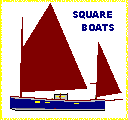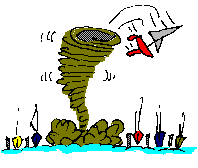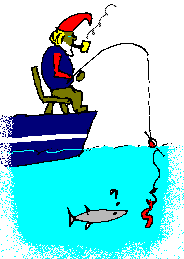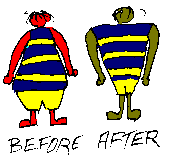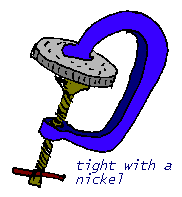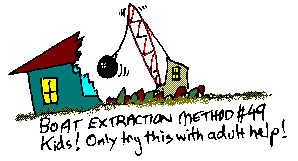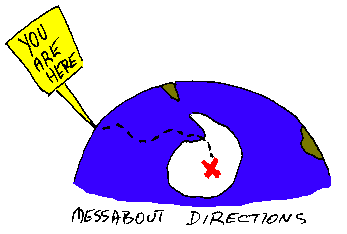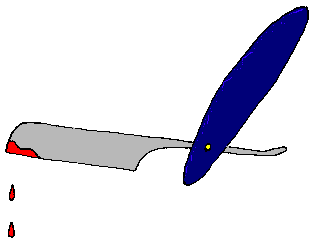|
C-shanty
on a Harmonica |
|
Text copyright (c) Chris Crandall, photo (c) Jim Michalak, doodles by Flying Tadpole (c) TJ Fatchen (whew!)
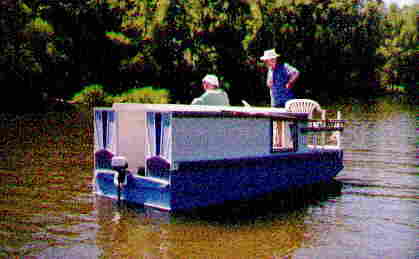
|
Chronic
boat disease
|
|
|
|
The 12-ft sharpie sailboat (a Bolger Teal) did not appeal to her, and the pair of 6-Hour Canoes got her out on the water only once. By now I had built four boats, and failed utterly in generating enthusiasm. (I could always set my standards lower . . . I managed to generate tolerance more than once.) I needed to find a boat that met her needs as well as mine. |
|
|
|
So, what does this woman want? Actually, it was very simple--she wanted peace and quiet, the ability to relax, comfort, and room to snooze. How can this be provided on a budget that does not admit yearly slip fees? I decided we needed a shanty boat. |
|
The boat is a big box, really, with an open slot-top, a swept-up transom bow, topped by a "porch" of a deck. It looked easy, cheap, able to be built with lumberyard materials, and if not handsome, at least it looked jaunty. I suspect that what really sold me on the design was the plans drawing of a man on the bow, with a foot up, drink in hand, hat forward over his eyes. This boat spoke to me; it said "easy-to-use". |
|
There are no photos of the building process. I'm extremely happy about the boat, and proud of it, even, so why are building photos so scarce? I am an eager boatbuilder, and like woodworking a lot, but I am a poor workplace maid. I simply didn't keep the workplace clean enough for construction photos that would not cause me shame.
If you can build a square box, then the Harmonica will pose no particular difficulties. OK, OK, I admit, I have trouble with building a square box. Still, the Harmonica is large enough that modest deviations from square are invisible. The couple of errors I made have even disappeared from my vision--only my building partner David Unruh knows the truth, and he's a pal--he's not telling. |
|
Decoration
design The other theory is to go for an American vernacular architectural style, and the most appropriate, in my opinion, is Victorian. Shantyboats were just taking shape as a phenomenon at the tail end of the Victorian era, and so the style has a whiff of authenticity to it. Plus, Victorian style is made for woodworking, and the colors look good. Victorian homes are mostly highly decorated boxes--the homes are square, but with lots of detail added, a perfect model for a shanty boat design originally named Fusebox. I set down to do some research. I was lucky. The Psychology Department at the University of California at Berkeley invited me to give a talk on cross-cultural research on prejudice toward fat people (it's easy to be the best in your specialty area when you're the only one in it), and we added a side trip to San Francisco to do research on Victorian architectural style. What it really meant was traipsing around the city looking at marvelous homes with unbelieveably detailed (and expensive!) paint schemes, and taking a trip down to the the Maritime National Historical Park at Hyde Street Pier. On a trip to Ghirardelli Square, I found an incredibly detailed and richly colored book on Victorian exterior paint schemes, complete with paint chips, brand names, and the theory of Victorian coloration. It was the first time I was able to engage my wife in boatbuilding decision making. The enthusiasms we acquire in pursuit of connubial bliss! We had the good fortune of staying in a hotel in Chinatown, and on the next block was a Chinese linen shop. Chinese decoration is consistent with Victorian style, and we bought a tablecloth and some placemats to cut into curtains for the boat's windows. Very authentic, and radical-cheap. |
|
|
|
Launch
date Excavating the shanty boat
from the basement
|
|
Occam's Razor was launched with power from a handy-dandy, corn-popper sounding, shrill-but-paid-for Tanaka 1.2hp outboard. It's not enough. The boat moved reasonably well, but we were reluctant to go out into the lake itself. We stayed the day in a tiny arm off the main lake. It was a great day of life at anchor, admiring and sharing other people's boats. After that 1st-rate day, we drove 400 miles back home. |
|
How we
actually use the boat (This is the section you should take most
seriously) Occam's Razor is a dream, too, but a modest one. Our hope was to take the boat out on lakes and rivers, anchor out once we've arrived, and eat, drink, swim, sleep, read, and talk. We have succeeded, and spectacularly. When the temperatures have reached 98F, we've gone out to the lake, and floated lazily in our PFD's, slept inside in the shade, or snoozed on an air mattress while afloat, tied to the boat. Occam's Razor is the single most relaxing place in Douglas County. Our ambitions have been remarkably modest, and the Harmonica class boat has genuinely delivered. We've had as many as 6 aboard (3 adults, 3 children), and as few as one. Two or three is the ideal number; four if everyone gets along. We've replaced the 2-stroke tiny Tanaka with a 4-stroke 5hp Nissan outboard. The difference is substantial. The motor isn't really quieter, but the pitch is bass instead of soprano. It's much more powerful, pollutes much less, and doesn't jangle the nerves or deafen the ears. Will the wife go shanty-boating? David and I like the boat a lot--it's been a great success, and we used it all last summer and fall. But how does my wife feel about Occam's Razor? She likes it. She's not crazy about it, but she's comfortable aboard, and enjoys a weekend day reading the paper or a novel, and eating a lunch I've made for her. She's not crazy smiling while aboard (like I am), but she enjoys the process. We're still hoping to get more people afloat--everyone likes it, but we're stingy with our quiet afternoons afloat. |
|
More info
about Harmonica and Shanty Boats A favorite book of mine is Harlan Hubbard's "Shantyboat: A river way of life" which was first published in 1953, and is still available from the University Press of Kentucky for about $14 (ISBN 0-8131-1359-8). I can strongly recommend its account of river life on the Ohio, Cumberland, and Mississippi Rivers in the 1940's. For more about life afloat on houseboats and other affordable on-the-water lifestyles, the best current reference is "Handmade houseboats: Independent living afloat" by Russell Conder, published in 1997, available from McGraw-Hill for about $20 (ISBN 0-0715-8022-0) |
|
|
Some
Internet Resources for the Harmonica: |
